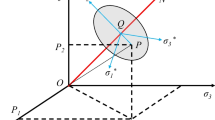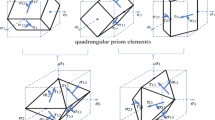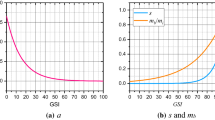Abstract
The Hoek–Brown strength criterion, which has been widely used in rock engineering, is one of the most influential rock strength criteria. Because this criterion does not take into account the effect of intermediate principal stress and because there are deficiencies in the theory and its practical application, for nearly 30 years many scholars have carried out research related to this topic. Yu and Zan took the advantages of the unified strength theory and integrated this theory with the Hoek–Brown strength criterion, thereby proposing the nonlinear unified strength criterion for rocks. This criterion takes into account the difference between the tensile strength and the compressive strength of rock, i.e. the intermediate principal stress effect, and the researchers determined that the limit loci in the meridian plane are nonlinear. The parameters of the nonlinear unified strength criterion are the same as those of the Hoek–Brown strength criterion obtained from conventional triaxial tests for rock blocks. The current study compared and analyzed the relationship between the nonlinear unified strength criterion and other three-dimensional Hoek–Brown strength criteria proposed by Pan and Hudson, Zhang and Zhu, and Jiang. Using the comparison of failure limit lines of the various strength criteria in the π-plane, the nonlinear unified strength criterion is superior to other strength criteria. Using the 1stOpt software of the general global optimization algorithm to fit the strength criterion parameters, the comparison of the results of the nonlinear unified strength criterion with the true triaxial test data from six types of rocks shows good agreement, and the true triaxial test of rock strength can be evaluated with high accuracy.








Similar content being viewed by others
References
Benz T, Schwab R, Kauther RA, Vermeer PA (2008) A Hoek–Brown criterion with intrinsic material strength factorization. Int J Rock Mech Min Sci 45:210–222. doi:10.1016/j.ijrmms.2007.05.003
Chang C, Haimson B (2000) True triaxial strength and deformability of the German Continental Deep Drilling Program (KTB) deep hole amphibolite. J Geophys Res 105:18999–19013. doi:10.1029/2000JB900184
Haimson BC, Chang C (2000) Anew true triaxial cell for testing mechanical properties of rock, and its use to determine rock strength and deformability of Westerly granite. Int J Rock Mech Min Sci 37:285–296. doi:10.1016/S1365-1609(99)00106-9
Hoek E, Brown ET (1980) Empirical strength criterion for rock masses. J Geotech Eng ASCE 106:1013–1035
Hoek E, Wood D, Shah S (1992) A modified Hoek–Brown criterion for jointed rock masses. In: Hudson JA (ed) Proceedings of the rock characterization, symposium of ISRM. British Geotechnical Society, London, pp 209–214
Hoek E, Carranza-Torres CT, Corkum B (2002) Hoek–Brown failure criterion—2002 edition. In: Hammah R, Bawden W, Curran J, Telesnicki M (eds) Proceedings of the Fifth North American rock mechanics symposium (NARMS-TAC). University of Toronto Press, Toronto, pp 267–273
Jiang H (2015) A simple convenient three-dimensional Hoek–Brown criterion for rocks. Chin J Rock Mech Eng 34(Suppl1):2996–3004 (in Chinese)
Jiang H, Wang XW, Xie YL (2011) New strength criteria for rocks under polyaxial compression. Can Geotech J 48:1233–1245. doi:10.1139/t11-034
Lu XY, Zhu HL, Lu XL, Liu JM, Zhou Y, Li XG (2015) A study on the inner surface pressure distribution of fluid in ninety degree elbow pipe. AMM 713–715:34–38. doi:10.4028/www.scientific.net/AMM.713-715.34
Mehranpour MH, Kulatilake PHSW (2016) Comparison of six major intact rock failure criteria using a particle flow approach under true-triaxial stress condition. Geomech Geophys Geo Energy Geo Res 2(4):203–229. doi:10.1007/s40948-016-0030-6
Mogi K (1971) Fracture and flow of rocks under high triaxial compression. J Geophys Res 76:1255–1269. doi:10.1029/JB076i005p01255
Mogi K (2007) Experimental rock mechanics. Taylor and Francis, London, p 64
Pan X, Hudson JA (1988) A simplified three dimensional Hoek–Brown yield criterion. In: Romana M (ed) Rock mechanics and power plants. Balkema, Rotterdam, pp 95–103
Shi XC, Meng YF, Li G (2011) Comparative analyses of several rock strength criteria. Rock Soil Mech 32(Suppl 1):209–216 (in Chinese)
Shi XC, Yang X, Meng YF, Li G (2016) Modified Hoek–Brown failure criterion for anisotropic rocks. Environ Earth Sci 75:995. doi:10.1007/s12665-016-5810-3
Single B, Goel RK, Mehrotra VK, Garg SK, Allu MR (1998) Effect of intermediate principal stress on strength of anisotropic rock mass. Tunn Undergr Space Technol 13:71–79. doi:10.1016/S0886-7798(98)00023-6
Vásárhelyi B, Kovács L, Török Á (2016) Analysing the modified Hoek–Brown failure criteria using Hungarian granitic rocks. Geomech Geophys Geo Energy Geo Res 2(2):131–136. doi:10.1007/s40948-016-0021-7
Wang R, Kemeny JM (1995) A new empirical criterion for rock under polyaxial compressive stresses. In: Daemen S (ed) Rock mechanics. Balkema, Rotterdam, pp 453–458
You M (2011) Comparison of the accuracy of some conventional triaxial strength criteria for intact rock. Int J Rock Mech Min Sci 48:852–863. doi:10.1016/j.ijrmms.2011.05.006
Yu MH (2011) New system of strength theory: theory, development and application, 2nd edn. Xi an Jiao Tong University Press, Xi an, pp 75–95 (in Chinese)
Yu MH, Zan YW, Zhao J, Yoshimine M (2002) A unified strength criterion for rock material. Int J Rock Mech Min Sci 39:975–989. doi:10.1016/S1365-1609(02)00097-7
Zan YW, Yu MH, Wang SJ (2002) Nonlinear unified strength criterion of rock. Chin J Rock Mech Eng 21:1435–1441 (in Chinese)
Zhang LY, Zhu HH (2007) Three-dimensional Hoek–Brown strength criterion for rocks. J Geotech Geoenviron Eng 133:1128–1135. doi:10.1061/(ASCE)1090-0241(2007)133:9(1128)
Zhang YP, Cao P, Dong LJ (2010) A robust regression model and its application in calculating shear strength of rock. Sci Technol Rev 28:91–95 (in Chinese)
Zhang H, Liu J, Cao Y, Wang Y (2013) Effects of particle size on lignite reverse flotation kinetics in the presence of sodium chloride. Powder Technol 246:658–663
Acknowledgements
We acknowledge our gratitude toward the sponsors of the work presented in this paper: the MOE’s Program for Changjiang Scholars and the Innovative Research Team (IRT13092).
Author information
Authors and Affiliations
Corresponding author
Rights and permissions
About this article
Cite this article
Yang, Q., Zan, Y. & Xie, L.G. Comparative analysis of the nonlinear unified strength criterion for rocks and other three-dimensional Hoek–Brown strength criteria. Geomech. Geophys. Geo-energ. Geo-resour. 4, 29–37 (2018). https://doi.org/10.1007/s40948-017-0072-4
Received:
Accepted:
Published:
Issue Date:
DOI: https://doi.org/10.1007/s40948-017-0072-4




